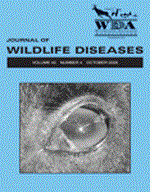Between 2001 and 2004, 14 Austrian free-ranging red deer (Cervus elaphus hippelaphus) infected by Mycobacterium avium species were observed. Eight of the cases were from different geographical regions, and six originated from the same hunting area. The affected animals had signs of diarrhea, severe weight loss, and emaciation. On post-mortem examination, lymphadenitis associated with grossly enlarged mesenteric lymph nodes as well as multiple caseous or purulent nodular lesions in the thickened wall of the intestines were present in all animals. In 10 cases M. avium subsp. avium and in four cases M. a. hominissuis were isolated. In three red deer, a mixed infection with M. a. hominissuis and M. a. paratuberculosis was evident. Typing of M. a. avium and M. a. hominissuis isolates was performed by polymerase chain reaction (PCR) detection of insertion sequence IS901 and the virulence-associated macrophage-induced gene (mig), inverted repeat (IR) typing (IS1245/IS1311), and random amplified polymorph DNA (RAPD) analysis. While all M. a. avium and M. a. hominissuis contained the mig gene, IS901 was detected only in M. a. avium. The prevalence of IS901-positive isolates correlated well with the geographic location of affected animals. The IS901-containing isolates were shown to be genotypically closely related, as they exhibit similar patterns in IR-typing and in RAPD analysis. In contrast, IS901-negative isolates (M. a. hominissuis) displayed distinct profiles in both molecular systems.
How to translate text using browser tools
1 October 2006
INFECTIONS CAUSED BY MYCOBACTERIUM AVIUM SUBSPECIES AVIUM, HOMINISSUIS, AND PARATUBERCULOSIS IN FREE-RANGING RED DEER (CERVUS ELAPHUS HIPPELAPHUS) IN AUSTRIA, 2001–2004
Walter Glawischnig,
Theodora Steineck,
Joachim Spergser

Journal of Wildlife Diseases
Vol. 42 • No. 4
October 2006
Vol. 42 • No. 4
October 2006
Cervus elaphus hippelaphus
DNA fingerprinting
mycobacteriosis
Mycobacterium avium subsp. avium
Mycobacterium avium subsp. hominissuis
Mycobacterium avium subsp. paratuberculosis
pathology




